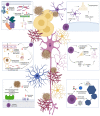Therapeutic Potential of Human Stem Cell Implantation in Alzheimer's Disease
- PMID: 34576314
- PMCID: PMC8471075
- DOI: 10.3390/ijms221810151
Therapeutic Potential of Human Stem Cell Implantation in Alzheimer's Disease
Abstract
Alzheimer's disease (AD) is a progressive debilitating neurodegenerative disease and the most common form of dementia in the older population. At present, there is no definitive effective treatment for AD. Therefore, researchers are now looking at stem cell therapy as a possible treatment for AD, but whether stem cells are safe and effective in humans is still not clear. In this narrative review, we discuss both preclinical studies and clinical trials on the therapeutic potential of human stem cells in AD. Preclinical studies have successfully differentiated stem cells into neurons in vitro, indicating the potential viability of stem cell therapy in neurodegenerative diseases. Preclinical studies have also shown that stem cell therapy is safe and effective in improving cognitive performance in animal models, as demonstrated in the Morris water maze test and novel object recognition test. Although few clinical trials have been completed and many trials are still in phase I and II, the initial results confirm the outcomes of the preclinical studies. However, limitations like rejection, tumorigenicity, and ethical issues are still barriers to the advancement of stem cell therapy. In conclusion, the use of stem cells in the treatment of AD shows promise in terms of effectiveness and safety.
Keywords: Alzheimer’s disease; Induced pluripotent stem cells; embryonic stem cells; mesenchymal stem cells; neural stem cells; neurodegenerative disease; neurogenesis; stem cell therapy; stem cell transplantation; stem cells.
Conflict of interest statement
All authors declare no conflict of interest.
Figures

References
-
- Kumar A., Sidhu J., Goyal A., Tsao J.W. StatPearls. StatPearls Publishing LLC.; Treasure Island, FL, USA: 2021. Alzheimer Disease.
-
- Emmady P.D., Tadi P., Del Pozo E. StatPearls. StatPearls Publishing LLC.; Treasure Island, FL, USA: 2021. Dementia (Nursing)
Publication types
MeSH terms
Grants and funding
LinkOut - more resources
Full Text Sources
Other Literature Sources
Medical

